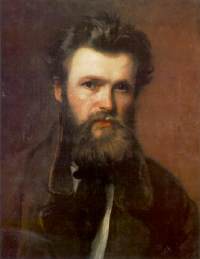IZSÓ Miklós
(1831, Disznóshorvát - 1875, Budapest)


Sculptor. He learnt at the College in Sárospatak from 1840. He took part in the war of independence in 1848-49. After the capitulation of Világos, he lived in exile. He became a stone-cutter in Rimaszombat from 1851 to 1856 where he was a pupil of István Ferenczy. He went to Pest in 1856. Supported by young writers, artists and musicians, he travelled to Vienna where he worked under Meixner, then Gasser, both sculptors. From 1859 onwards he attended the Academy in Munich.
He was the first sculptor attracted by life in the country ("Shepherd Playing the Flute"). The statue of "Grieving Shepherd" of the Munich period (1862) was appreciated by critics. On his return to Hungary the same year, he modelled busts of contemporary personalities ("János Arany", "Gábor Egressy", "Károly Megyeri", "András Fáy", "Kálmán D. Lisznyay" in 1863, "István Márton", "Pál Almási Balogh", "Károly Ghiczy", "Ilona Zrinyi" and "Ferenc Rákóczi II" in 1870). He modelled scenes from life in the country ("Gypsy Laokoon", 1862, "In the Spinnery", "The Drunkard", "Woman at Harvest", "Peasant Woman Carrying Food", 1863, and "Peasant Girl", 1864). He modelled the statue of Csokonai in 1866-67, his only statue erected.
He visited Italy in winter 1868-69. He was a teacher at the School of Decorative Arts from 1871 onwards. The small terracotta figures, his most famous works, date from 1864-70. He died of tuberculosis at the age of 24. His last works, the statue of Petőfi (Budapest) and the Dugonics Memorial (Szeged) were finished by Adolf Huszár.
